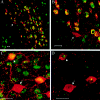X-chromosome inactivation patterns are unbalanced and affect the phenotypic outcome in a mouse model of rett syndrome
- PMID: 14973779
- PMCID: PMC1182264
- DOI: 10.1086/382228
X-chromosome inactivation patterns are unbalanced and affect the phenotypic outcome in a mouse model of rett syndrome
Abstract
Rett syndrome (RTT), a neurodevelopmental disorder affecting mostly females, is caused by mutations in the X-linked gene encoding methyl-CpG-binding protein 2 (MeCP2). Although the majority of girls with classic RTT have a random pattern of X-chromosome inactivation (XCI), nonbalanced patterns have been observed in patients carrying mutant MECP2 and, in some cases, account for variability of phenotypic manifestations. We have generated an RTT mouse model that recapitulates all major aspects of the human disease, but we found that females exhibit a high degree of phenotypic variability beyond what is observed in human patients with similar mutations. To evaluate whether XCI influences the phenotypic outcome of Mecp2 mutation in the mouse, we studied the pattern of XCI at the single-cell level in brains of heterozygous females. We found that XCI patterns were unbalanced, favoring expression of the wild-type allele, in most mutant females. It is notable that none of the animals had nonrandom XCI favoring the mutant allele. To explore why the XCI patterns favored expression of the wild-type allele, we studied primary neuronal cultures from Mecp2-mutant mice and found selective survival of neurons in which the wild-type X chromosome was active. Quantitative analysis indicated that fewer phenotypes are observed when a large percentage of neurons have the mutant X chromosome inactivated. The study of neuronal XCI patterns in a large number of female mice carrying a mutant Mecp2 allele highlights the importance of MeCP2 for neuronal viability. These findings also raise the possibility that there are human females who carry mutant MECP2 alleles but are not recognized because their phenotypes are subdued owing to favorable XCI patterns.
Figures






References
Electronic-Database Information
-
- Neuron, http://www.neuron.org/content/full/35/2/243/DC1 (for Shahbazian et al. video)
-
- Online Mendelian Inheritance in Man (OMIM), http://www.ncbi.nlm.nih.gov/Omim/ (for RTT) - PubMed
-
- RettBASE: IRSA MECP2 Variation Database, http://mecp2.chw.edu.au/ - PubMed
References
-
- Adler DA, Quaderi NA, Brown SD, Chapman VM, Moore J, Tate P, Disteche CM (1995) The X-linked methylated DNA binding protein, Mecp2, is subject to X inactivation in the mouse. Mamm Genome 6:491–492 - PubMed
-
- Amir RE, Van den Veyver IB, Schultz R, Malicki DM, Tran CQ, Dahle EJ, Philippi A, Timar L, Percy AK, Motil KJ, Lichtarge O, Smith EO, Glaze DG, Zoghbi HY (2000) Influence of mutation type and X chromosome inactivation on Rett syndrome phenotypes. Ann Neurol 47:670–67910.1002/1531-8249(200005)47:5<670::AID-ANA20>3.3.CO;2-6 - DOI - PubMed
-
- Armstrong DD, Deguchi K, Antallfy B (2003) Survey of MeCP2 in the Rett syndrome and the non-Rett syndrome brain. J Child Neurol 18:653–660 - PubMed
Publication types
MeSH terms
Substances
Grants and funding
LinkOut - more resources
Full Text Sources
Medical
Molecular Biology Databases

